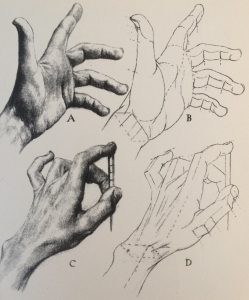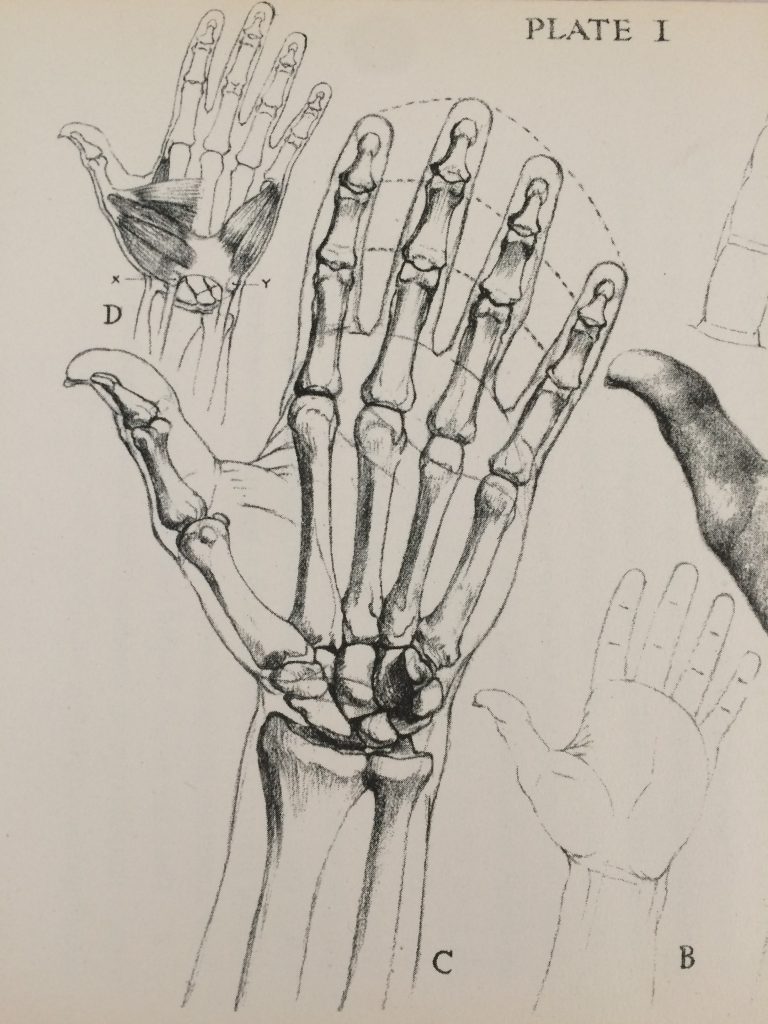[Note: this post is part of a series on the “substance of the craft” of scholarly writing. Inspired by by Wayne Booth (co-author of The Craft of Research) and Oliver Senior (author of How to Draw Hands), I argue that composition is the coordination of words and ideas, paragraphs and propositions, sentences and the state of things.]
“We picture facts to ourselves,” said Wittgenstein. And a thought, he explained, is a “logical picture of facts.”
Think for a moment of your hand. (You can take a look, of course, but the important thing for my purposes is that you think. If you have to close your eyes, that’s okay too.) The hand, Oliver Senior tells us, is “a familiar yet highly complex piece of physical mechanism which is almost infinitely adaptable in use.” Imagine your hand open, held out, perhaps, in greeting, or imagine your fist clenched in anger. Picture your hand in these positions. Now, imagine it picking up and holding a delicate instrument. Your hand, says Senior, is capable of “multitudinous individual variations of character as well as changes of appearance in its great range of different positions, actions and movements, yet always conforming to a recognisable standard pattern and subject to strict laws of its own structure.” You can picture it, right?
With a little practice you can learn to draw these pictures. When you become good at it, you can represent the hand in its full variety of positions, always in accordance with the laws of its structure. You learn to see the hand “objectively”, constrained (and enabled) in its movements by its physiology, its reality. Your drawings become increasingly “realistic” because each drawing can be traced back to a recognizable pattern, to which it conforms. Each drawing is logically compatible with the other drawings — it’s simply a transformation of the possibilities in the others. Unless you imagine that your hand is broken (which you are free to imagine if you dare), certain pictures are impossible, unimaginable, unthinkable.
“In a proposition a thought finds an expression that can be perceived by the senses,” said Wittgenstein. That is, a proposition expresses a logical picture of facts. “My hand is empty,” is a proposition. “My fist is clenched,” is another. (“My finger is broken,” is a third.) You can imagine my hand (or yours) in these situations. “Objects contain the possibility of all situations,” said Wittgenstein. “The possibility of its occurring in states of affairs is the form of an object.” We can represent these possible states of affairs (these possible facts) in pictures and in propositions. We can draw them or we can write them down.
In scholarly writing, we arrange propositions (expressions of thoughts, i.e., sentences) into paragraphs that together represent a situation, a state of affairs, a set of facts. They may be facts about a company, a country, or a current event. They may be facts about the state of the literature or the methods you have used to gather data. They may be very abstract facts about the concepts you have used to model reality. But in all cases, you are claiming that something is true and, importantly, that a great deal more is possible. A paragraph, like a picture of a hand, doesn’t just confine itself to how things look right now, right here. A paragraph conforms to a “standard pattern” of reality so that the facts that are represented also imply the possibility (and impossibility) of other facts. The paragraph presents a logical picture of the facts; it expresses a series of thoughts about them. The reader must be able to imagine it.
This underlying logic of paragraphs also has implications for their arrangement. As readers pass from paragraph to paragraph, their imaginations are exposed to pictures of various facts. But these facts must conform to the pattern that is being established in the text. It must be possible to imagine what Hemingway called the “sequence of motion and fact” that brings us from one state of affairs to another, without breaking the bones, if you will, of the structure of the argument. (Of course, you can write a paragraph where those bones are explicitly broken if you need to. Now the reader will be able to imagine the painful contortions to come. Please remember to be as kind to your reader as you can.) Your concepts and objects will often be highly complex* mechanisms, but they should be familiar to you, and they should become increasingly familiar to your reader. Every time you depict them in a paragraph, they should become easier to imagine.
Try not to make this more difficult or philosophical or even mystical than I may, unfortunately, have made it sound. A paragraph consists of at least six sentences (propositions, thoughts) and at most 200 words. Like a drawing, it usually occupies no more than a page. You can read it in about a minute, just as you can study a drawing for that long and get some useful information out of it. Just as a drawing isn’t the whole or final truth about your hand, but only your hand in a particular position in a particular situation, a paragraph asserts only particular truths about the concepts or objects it describes. The important thing is to make a definite claim (cf. “this is a fist, clenched in anger,”) and then support, elaborate, or defend this claim within the space of two-hundred words (cf., “in each purposeful line or passage of [your] drawing, achieve … an expression of form, character, action …”). Appreciate the finitude of the problem and develop your craft from a realistic point of view.
“The world is everything that is case,” said Wittgenstein. “Objects contain the possibility of all situations.” And, yes, “What we cannot speak about we must consign to silence.” He said that too.
_____
*A note for Wittgensteinians: I know that Wittgenstein says that “objects are simple” (T2.02). But in ordinary language objects can be more or less complex. The early Wittgenstein would refer to what I (and I assume most of my readers) think of as “objects” as “facts” at this point and distinguish “atomic” ones from the rest. Wittgenstein of course ended up abandoning the idea of “atomic facts” composed of simple “objects”. But I have retained the idea that the difference between ordinary things and objects of inquiry is that the latter “contain the possibilities” of their combination with other objects, while “things” are just lying around, if you will, taking up space. (Objects occupy logical space, let’s say.) I know that’s not particularly rigorous and won’t satisfy all philosophers, but hope you’ll acknowledge that I’m making an effort. Even after all these years, my reading of Wittgenstein continues to evolve. May yours, also.


Sometimes when teaching, I have analogized writing structure to the fractal structure of a fern frond, with paragraphs as a bit like a pinna:
https://www.fs.fed.us/wildflowers/beauty/ferns/structure.shtml
The overall structure of a piece of (expository) writing has an introduction, and middle sections with support and details and elaboration. Following a similar structure are paragraphs (as you describe). The analogy breaks down a bit at the sentence level but even there, there is something of a similar structure with a beginning part, a middle and an end.
All the pinnules (the sentences of a paragraph) are tied to together by the narrative of that paragraph (the midribs of the pinna. All of the pinna are tied together by the narrative of the overall structure (the midrib of the frond).
At any given point, you can find where you are on the structure and see where and how the section you are in fits back on to the overall structure. If you on a pinnule, you can see it’s located in a particular part of a pinna, and you can find your way, predictably, back to the midrib of the pinna and then the midrib of the whole frond.
You can always predict what will come next, and even if you got to where you are blindfolded you could find your way back because of the logic of the structure.
I’m not entirely sure it ever made sense to students. But I like it. And I like to think that even if the details fell apart somewhat, it helped them to see that there’s always an overall structure to a piece of writing, that it’s a series of recursions of different categories of size (sentences, paragraphs, sections) tied together with by a narrative. That you can (ideally) always see where you are in the structure and know how it fits into the overall pattern and how to find your way back to the organizing structure.
I’d love to hear thoughts. Crazy? Maybe not crazy but just doesn’t work? Brilliant?
My posts on “Sentences, Paragraphs, and Essays” and “Seconds, Minutes, and Hours” touched on similar issues, though I guess my metaphor is more one of “nested” processes than fractal recursion. That is, I don’t think the process can be continued indefinitely in both directions — we can’t keep “zooming” in or out and discover the same patterns, although there is no doubt that the patterns in our words, sentences, paragraphs, and essays are interrelated and do sometimes reference each other.
It’s a great image, though. As you point out, it’s all about whether it makes sense to the writer who is trying to use it to understand their text.
Thanks,
I’ll give the idea of nested processes some thought. I think I like it.